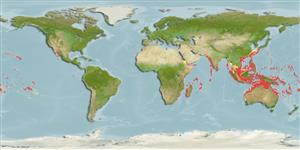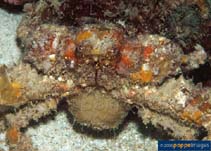Daldorfia horrida (Linnaeus, 1758)
Horrid elbow crab| Native range | All suitable habitat | Point map | Year 2050 |

|
| This map was computer-generated and has not yet been reviewed. |
| Daldorfia horrida AquaMaps Data sources: GBIF OBIS |
Classification / Names Common names | Synonyms | CoL | ITIS | WoRMS
Malacostraca | Decapoda | Parthenopidae
Environment: milieu / climate zone / depth range / distribution range Ecology
Reef-associated; depth range 0 - 125 m (Ref. 105618). Tropical; 32°N - 31°S, 30°E - 108°W
Distribution Countries | FAO areas | Ecosystems | Occurrences | Introductions
Indo-Pacific. Tropical and subtropical.
Length at first maturity / Size / Weight / Age
Maturity: Lm ? range ? - ? cm Max length : 14.0 cm CL male/unsexed; (Ref. 128968)
Life cycle and mating behavior Maturity | Reproduction | Spawning | Eggs | Fecundity | Larvae
Main reference
References | Coordinator | Collaborators
Poupin, J. 2050 Database of Crustacea (Decapoda and Stomatopoda), from Central Pacific Islands (French Polynesia, Pitcairn, Easter Island, Clipperton). Http://decapoda.ecole-navale.fr/index.php and http://decapoda.free.fr. [Accessed 160207]. (Ref. 2891)
IUCN Red List Status
(Ref. 130435: Version 2025-1)
CITES status (Ref. 108899)
CMS (Ref. 116361)
Threat to humans
Human uses
Fisheries: commercial
| FishSource | Sea Around Us
Tools
More information
Max. ages / sizes
Length-weight rel.
Length-length rel.
Length-frequencies
Mass conversion
Abundance
Internet sources
BHL | BOLD Systems | CISTI | DiscoverLife | FAO(Publication : search) | Fishipedia | GenBank (genome, nucleotide) | GloBI | Gomexsi | Google Books | Google Scholar | Google | PubMed | Tree of Life | Wikipedia (Go, Search) | Zoological Record



